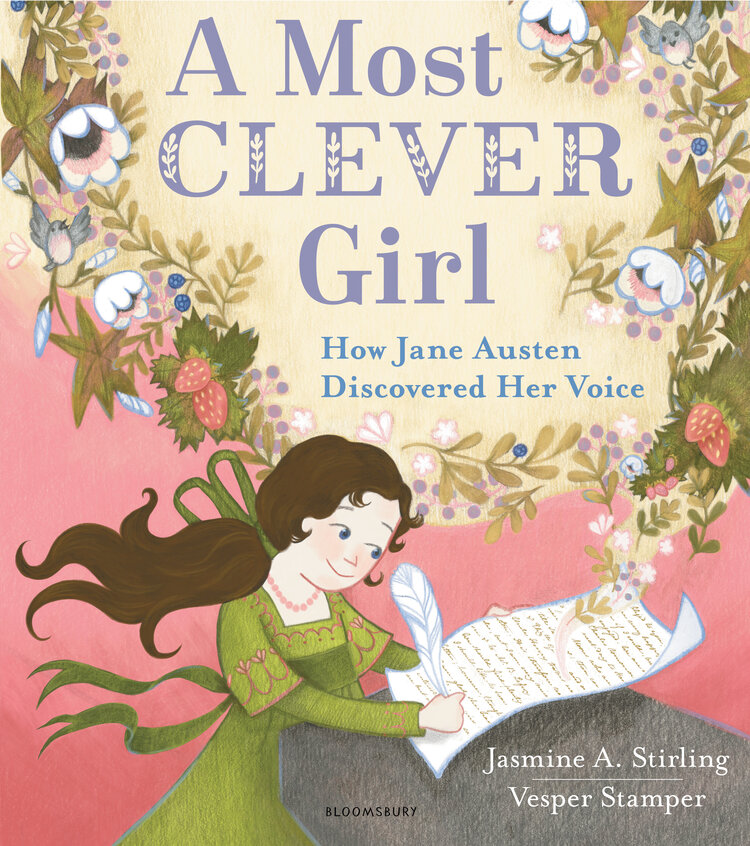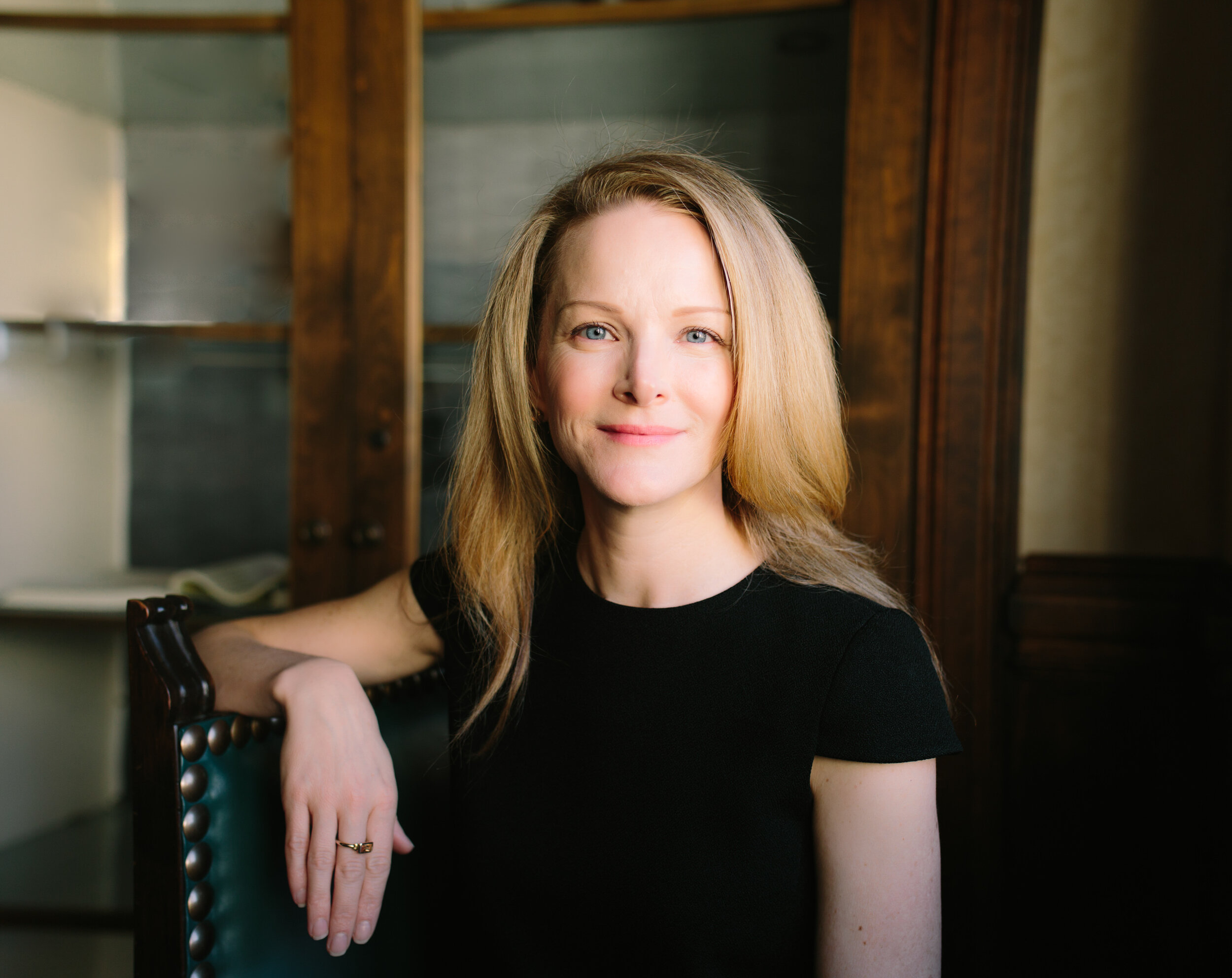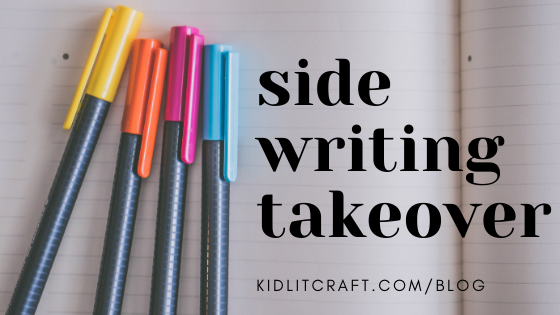interview by Anne-Marie Strohman
Sidewriting Takeover brings together writers of picture books, middle grade, and young adult fiction to explore how writing outside of a draft can help deepen your drafts and revisions. Each writer shares an exercise that they’ve found helpful. If you missed our initial post: START HERE.
I met Jasmine A. Stirling through a mutual friend when she was working on an early version of her picture book biography of Jane Austen, A Most Clever Girl (March 2021). I was lucky enough to read that draft, and it is so fun to see how the story has changed since then and become the beautiful book that you can find on bookstore shelves! The story changed quite a bit, but it still has the heart and passion I found in the version I read, and she has captured the joy and heartache of Austen’s life and writing. I’m so pleased to hear about Jasmine’s slow movement toward sidewriting, and I hope it can be an inspiration for you. –Anne-Marie
KidLit Craft: How has sidewriting become a part of your writing process?

Jasmine A. Stirling: For my initial published projects (A Most Clever Girl, out now, and We Demand an Equal Voice, out in early 2022) and another current work in progress, I did almost no sidewriting. I am an ambitious re-writer, but I haven’t done many writing exercises—either to support the development of a manuscript or to develop my own writing. I greatly enjoy doing writing exercises, but usually simply do not take the time to do them. I like to delve very deeply into the project that I am working on and re-work it over and over. I tend to add layers and layers to develop my themes. I think sidewriting is fun and playful, and I’d like to allow myself to take the time to do more of it. And I am doing just that with my current project—my first novel.
My novel is set in contemporary San Francisco and features motifs related to Victorian nonsense poetry (such as that written by Edward Lear) as well as the mathematical games of Lewis Carroll. So I’m starting to explore the limits and possibilities of these motifs by doing Carroll’s games and puzzles, by creating riddles that could be based on those games and puzzles, and by picking out characters from Lear’s and Carroll’s poetry and exploring how to turn them into people or creatures in the book. I’m also thinking about how to turn inward and outward themes into story elements that integrate with these motifs. I’ll be doing sidewriting to facilitate this.
KLC: At what points in the process of writing a novel do you sidewrite most?
JAS: When I wrote A Most Clever Girl and We Demand an Equal Voice, my research and exploration process occurred as much while I was writing as before I began. I imagine that with this novel, I will do a lot more before I begin, as I plan to plot out the book.
I’m a plotter and and not a panster, but I’m also a writer who tends to completely re-write everything multiple times, and during those re-writes, I typically go in new directions. And every time a new direction comes up, more sidewriting opportunities arise.
One thing I’m conscious of when re-writing is trying to make sentences do multiple things at once. If a sentence tells me about a character and includes or resolves conflict and moves the plot forward and tells me about the time period and is beautiful (or funny, or exciting), I’m doing my job.
KLC: How does sidewriting help you?
JAS: Among other things, sidewriting allows me to explore the motifs that I’m working with and develop their potential. As I mentioned, I enjoy layering themes and motifs and weaving them throughout the story in obvious and not-so-obvious ways. I also love putting hidden messages or “Easter eggs” for those who know the history behind my subject to find and enjoy. In A Most Clever Girl, I planted references to Austen’s letters, juvenilia, and novels for Austenites to discover on almost every page. My goal with Easter eggs is to create another opportunity for delight and pleasure that extends beyond the story itself and is in conversation with history and art more broadly.
Sidewriting Challenge: Riff on Your Influences
Words and sounds: Come up with lists of words relevant to motifs in your story and play with how they might be incorporated into your book. Think about the kinds of sounds you want in your sentences and eliminate words from your list that don’t have these sounds. Keep the list handy as you write to keep you on track.

History: Research the history and biographies of people loosely connected with motifs in your book and see if you can incorporate aspects of their stories to your characters. For example, I’m looking at the lore around the inspiration for various Edward Lear poems, which often includes people Edward knew. I’m researching those people and then adding references to them in my characters.
Literature, etc: Study literature, games, news, scientific discoveries, or other aspects of motifs or a time period connected with your story and explore how to bring those influences into your current project. For example, I’m exploring how to bring specific creatures and references from nonsense poetry directly or indirectly into my novel.
Symbols: Brainstorm symbols that are relevant to motifs in your story and that also communicate the personalities of your characters or make tangible the inner struggles that your characters are going through.
Look for double or triple duty: You’ll come up with lots of ideas when you sidewrite, but use only the ideas that are relevant to your protagonist’s internal or external struggle in your story. These are the ideas that do double or triple duty: they’re not just interesting, they’re interesting and meaningful. Discard the rest.
Sidewriting Challenge: Audition Your Characters
This one is from my mother, Diana, who is also a writer.
Hold “auditions” for the characters you’re considering for your story. Play the casting director and run your prospective characters through a series of exercises to see if they are a good fit. (For example, have them read lines of dialogue or act out a specific scene). You can find out how each character performs under pressure, how they relate to the casting director (you) and their fellow actors (other characters). You decide who gets called back and cut. You can also do reference calls on the finalists, and put two characters together to see what their chemistry is like.

Jasmine A. Stirling is an author who lives on a cheerful street in San Francisco with her husband, two daughters, and their dog. Her debut picture book, A Most Clever Girl: How Jane Austen Discovered Her Voice, illustrated by Vesper Stamper came out from Bloomsbury in March, 2021. She first fell in love with Jane Austen as a student at Oxford, where she read her favorite of Jane’s six masterful novels, Persuasion. When she’s not writing, Jasmine can be found hiking in the fog, singing songs from old musicals, and fiddling with her camera.
Visit her at www.jasmineastirling.com and follow her on Instagram, where she posts about kidlit and life with two young girls.
For more of our Sidewriting Takeover series, check out these posts:
Gossip Your Way Through the Story with Mary Winn Heider
Writing for Emotional Power with Sarah S. Davis
Dive into Character Relationships with David Macinnis Gill
Exploring a Character’s Misbelief with Jen Jobart
Asking the Right Questions with Louise Hawes
Subscribe to our monthly newsletter: it’s full of writing tips, featured author content, and inspiration.
Anne-Marie Strohman (co-editor) writes picture books, middle grade novels, and young adult short stories and novels. She is trained as a teacher, an editor, and a scholar, specializing in Renaissance Literature. She holds an MFA in Writing for Children and Young Adults from Vermont College of Fine Arts and is an active member of SCBWI. Find her at amstrohman.com and on Twitter @amstrwriter.


COMMENTs:
0